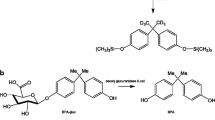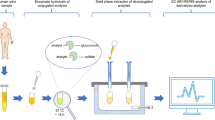Abstract
Bisphenol A (BPA) is a synthetic industrial reactant used in the production of polycarbonate plastics, and genistein is a natural phytoestrogen abundant in the soybean. Current studies investigating the endocrine-disrupting effects of concomitant exposures to BPA and genistein have warranted the development of an analytical method for the simultaneous measurement of BPA and genistein, as well as their primary metabolites, bisphenol A ß-d-glucuronide (BPA gluc) and genistein 4′-ß-d-glucuronide (genistein gluc), respectively. All four analytes were extracted from rat plasma via solid phase extraction (SPE). Three SPE cartridges and four elution schemes were tested. Plasma extraction using Bond Elut Plexa cartridges with sequential addition of ethyl acetate, methanol, and acetonitrile yielded optimal average recoveries of 98.1 ± 1.8% BPA, 94.9 ± 8.0% genistein, 91.4 ± 6.1% BPA gluc, and 103 ± 6.1% genistein gluc. Identification and quantification of the four analytes were performed by a validated HPLC-MS/MS method using electrospray ionization and selective reaction monitoring. This novel analytical method should be applicable to the measurement of BPA, genistein, BPA gluc, and genistein gluc in urine, cultures, and tissue following in vivo exposures. While reports of the determination of BPA and genistein independently exist, the simultaneous optimized extraction and detection of BPA, genistein, BPA gluc, and genistein gluc have not previously been reported.

BPA and genistein co-exposure scenario. BPA-laden polycarbonate plastic baby bottle filled with soymilk, a rich source of genistein, provides a classic exposure scenario to young children—a population that is particularly vulnerable to the effects of endocrine-disrupting compounds




Similar content being viewed by others
Abbreviations
- ESI:
-
Electrospray ionization
- HPLC:
-
High-performance liquid chromatography
- MS:
-
Mass spectrometry
- MS/MS:
-
Tandem MS
- RSD:
-
Relative standard deviation
References
Casanova M, You L, Gaido KW, Archibeque-Engle S, Janszen DB, Heck HD (1999) Developmental effects of dietary phytoestrogens in Sprague–Dawley rats and interactions of genistein and daidzein with rat estrogen receptors alpha and beta in vitro. Toxicol Sci 51:236–244
Peterson G, Barnes S (1993) Genistein and biochanin A inhibit the growth of human prostate cancer cells but not epidermal growth factor receptor tyrosine autophosphorylation. Prostate 22:335–345
Richter CA, Birnbaum LS, Farabollini F, Newbold RR, Rubin BS, Talsness CE, Vandenbergh JG, Walser-Kuntz DR, vom Saal FS (2007) In vivo effects of bisphenol A in laboratory rodent studies. Reprod Toxicol 24:199–224
Rubin BS, Murray MK, Damassa DA, King JC, Soto AM (2001) Perinatal exposures to low doses of bisphenol A affects body weight, patterns of estrous cyclicity, and plasma LH levels. Environ Health Perspect 109:675–680
Hannas BR, Furr J, Lambright CS, Wilson VS, Foster PMD, Gray LE Jr (2011) Dipentyl phthalate dosing during sexual differentiation disrupts fetal testis function and postnatal development of the Sprague–Dawley rat with greater relative potency than other phthalates. Toxicol Sci 120:184–193
Armenti AE, Zama AM, Passantino L, Uzumcu M (2008) Developmental methoxychlor exposure affects multiple reproductive parameters and ovarian folliculogenesis and gene expression in adult rats. Toxicol Appl Pharmacol 233:286–296
Perez P, Pulgar R, Olea-Serrano F, Villaloboa M, Rivas A, Metzler M, Pedraza V, Olea N (1998) The estrogenicity of bisphenol A-related diphenylalkanes with various substituents at the central carbon and the hydroxy groups. Environ Health Perspect 106:167–174
Lim DS, Kwack SJ, Kim KB, Kim HS, Lee BM (2009) Potential risk of bisphenol A migration from polycarbonate containers after heating, boiling, and microwaving. J Toxicol Environ Health A 72:1285–1291
Kuiper GG, Lemmen JG, Carlsson B B, Corton JC, Safe SH, van der Saag PT, van der Burg B, Gustafsson JA (1998) Interaction of estrogenic chemicals and phytoestrogens with estrogen receptor beta. Endocrinology 139:4252–4263
Xing L, Xu Y, Xiao Y, Shang L, Liu R, Wei X, Jiang J, Hao W (2010) Embryotoxic and teratogenic effects of the combination of bisphenol A and genistein on in vitro cultured postimplantation rat embryos. Toxicol Sci 115:577–588
vom Saal FS, Cooke PS, Buchanan DL, Palanza P, Thayer KA, Nagel SC, Parmigiani S, Welshons WV (1998) A physiologically based approach to the study of bisphenol A and other estrogenic chemicals on the size of reproductive organs, daily sperm production, and behavior. Toxicol Ind Health 14:239–260
Howdeshell KL, Hotchkiss AK, Thayer KA, Vandenbergh JG, vom Saal FS (1999) Exposure to bisphenol A advances puberty. Nature 401:763–764
NIH (2008) NTP-CERHR monograph on the potential human reproductive and developmental effects of bisphenol A, National Toxicology Program. NIH Publication no. 08-5994, September 2008
Thigpen JE, Setchell KDR, Saunders JE, Haseman JK, Grant MG, Forsythe DB (2004) Selecting the appropriate rodent diet for endocrine disruptor research and testing studies. ILAR J 45:401–416
Shelnutt SR, Cimino CO, Wiggins PA, Badger TM (2000) Urinary pharmacokinetics of the glucuronide and sulfate conjugates of genistein and daidzein. Cancer Epidemiol Biomarkers Prev 9:413–419
Albertazzi P (2002) Purified phytoestrogens in postmenopausal bone health: is there a role for genistein? Climacteric 5:190–196
Akiyama T, Ishida J, Nakagawa S, Ogawara H, Watanabe S, Itoh N, Shibuya M, Fukami Y (1987) Genistein, a specific inhibitor of tyrosine-specific protein kinases. J Biol Chem 262:5592–5595
Messina M, McCaskill-Stevens W, Lampe JW (2006) Addressing the soy and breast cancer relationship: review, commentary, and workshop proceedings. J Natl Cancer Inst 98:1275–1284
Ball ER, Caniglia MK, Wilcox JL, Overton KA, Burr MJ, Wolfe BD, Sanders BJ, Wisniewski AB, Wrenn CC (2010) Effects of genistein in the maternal diet on reproductive development and spatial learning in male rats. Horm Behav 57:313–322
Patisaul HB, Polston EK (2008) Influence of endocrine active compounds on the developing rodent brain. Brain Res Rev 57:352–362
Jefferson WN, Couse JF, Padilla-Banks E, Korach KS, Newbold RR (2002) Neonatal exposure to genistein induces estrogen receptor (ER)alpha expression and multioocyte follicles in the maturing mouse ovary: evidence for ERbeta -mediated and nonestrogenic actions. Biol Reprod 67:1285–1296
Yi B, Kim C, Yang M (2010) Biological monitoring of bisphenol A with HLPC/FLD and LC/MS/MS assays. J Chromatogr B Analyt Technol Biomed Life Sci 878:2606–2610
Rezaee M, Yamini Y, Shariati S, Esrafili A, Shamsipur M (2009) Dispersive liquid–liquid microextraction combined with high-performance liquid chromatography-UV detection as a very simple, rapid and sensitive method for the determination of bisphenol A in water samples. J Chromatogr A 1216:1511–1514
Valentin-Blasini L, Blount BC, Rogers HS, Needham LL (2000) HPLC-MS/MS method for the measurement of seven phytoestrogens in human serum and urine. J Expo Anal Environ Epidemiol 10:799–807
Twaddle NC, Churchwell MI, Doerge DR (2002) High-throughput quantification of soy isoflavones in human and rodent blood using liquid chromatography with electrospray mass spectrometry and tandem mass spectrometry detection. J Chromatogr B Analyt Technol Biomed Life Sci 777:139–145
Wilkinson AP, Wahala K, Williamson G (2002) Identification and quantification of polyphenol phytoestrogens in foods and human biological fluids. J Chromatogr B Analyt Technol Biomed Life Sci 777:93–109
Xiao Q, Li Y, Ouyang H, Xu P, Wu D (2006) High-performance liquid chromatographic analysis of bisphenol A and 4-nonylphenol in serum, liver and testis tissues after oral administration to rats and its application to toxicokinetic study. J Chromatogr B Analyt Technol Biomed Life Sci 830:322–329
Zhao RS, Wang X, Yuan JP (2010) Highly sensitive determination of tetrabromobisphenol A and bisphenol A in environmental water samples by solid-phase extraction and liquid chromatography–tandem mass spectrometry. J Sep Sci 33:1652–1657
Hosoda K, Furuta T, Yokokawa A, Ogura K, Hiratsuka A, Ishii K (2008) Plasma profiling of intact isoflavone metabolites by high-performance liquid chromatography and mass spectrometric identification of flavone glycosides daidzin and genistin in human plasma after administration of kinako. Drug Metab Dispos 36:1485–1495
Churchwell MI, Twaddle NC, Meeker LR, Doerge DR (2005) Improving LC-MS sensitivity through increases in chromatographic performance: comparisons of UPLC-ES/MS/MS to HPLC-ES/MS/MS. J Chromatogr B Analyt Technol Biomed Life Sci 825:134–143
Howes LG, Howes JB, Knight DC (2006) Isoflavone therapy for menopausal flushes: a systematic review and meta-analysis. Maturitas 55:203–211
Olea N, Pulgar R, Perez P, Olea-Serrano F, Rivas A, Novillo-Fertrell A, Pedraza V, Soto AM, Sonnenschein C (1996) Estrogenicity of resin-based composites and sealants used in dentistry. Environ Health Perspect 104:298–305
Stiles R, Yang I, Lippincott RL, Murphy E, Buckley B (2007) Potential sources of background contaminants in solid phase extraction and microextraction. J Sep Sci 30:1029–1036
Acknowledgments
The authors would like to thank the National Institutes of Health (grant no. T32ES007148), National Institute of Environmental Health Sciences (grant no. ES05022), and Environmental and Occupational Health Sciences Institute for financial support. A special thank you to Stuart Shalat for performing the statistical analysis for residual percent error.
Author information
Authors and Affiliations
Corresponding author
Electronic supplementary material
Below is the link to the electronic supplementary material.
ESM 1
(PDF 101 kb)
Rights and permissions
About this article
Cite this article
Coughlin, J.L., Winnik, B. & Buckley, B. Measurement of bisphenol A, bisphenol A ß-d-glucuronide, genistein, and genistein 4′-ß-d-glucuronide via SPE and HPLC-MS/MS. Anal Bioanal Chem 401, 995–1002 (2011). https://doi.org/10.1007/s00216-011-5151-8
Received:
Revised:
Accepted:
Published:
Issue Date:
DOI: https://doi.org/10.1007/s00216-011-5151-8




